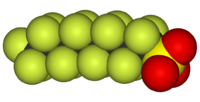
Photo from wikipedia
Poly- and perfluorinated substances (PFAS) comprise more than 3000 individual compounds; nevertheless, most studies to date have focused mainly on the fate, transport and remediation of long-chain PFAS (C > 7). The… Click to show full abstract
Poly- and perfluorinated substances (PFAS) comprise more than 3000 individual compounds; nevertheless, most studies to date have focused mainly on the fate, transport and remediation of long-chain PFAS (C > 7). The main objective of this article is to provide the first critical review of the peer-reviewed studies on the analytical methods, occurrence, mobility, and treatment for ultra-short-chain PFAS (C = 2-3) and short-chain PFAS (C = 4-7). Previous studies frequently detected ultra-short-chain and short-chain PFAS in various types of aqueous environments including seas, oceans, rivers, surface/urban runoffs, drinking waters, groundwaters, rain/snow, and deep polar seas. Besides, the recent regulations and restrictions on the use of long-chain PFAS has resulted in a significant shift in the industry towards short-chain alternatives. However, our understanding of the environmental fate and remediation of these ultra-short-chain and short-chain PFAS is still fragmentary. We have also covered the handful studies involving the removal of ultra-short and short-chain PFAS and identified the future research needs.
Journal Title: Chemosphere
Year Published: 2019
Link to full text (if available)
Share on Social Media: Sign Up to like & get
recommendations!